News
BMW and the future of motorcycling
BMW previews the e-fuels, active safety systems, wearable tech and more it hopes will futureproof powered two-wheelers
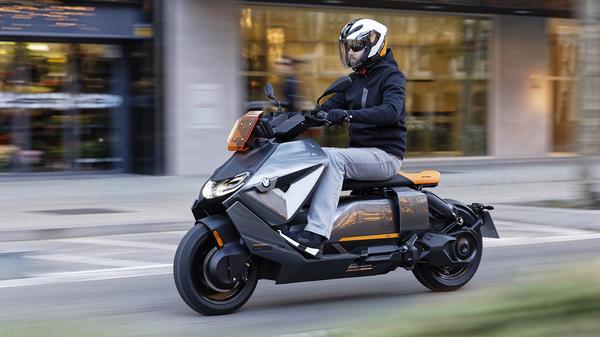

Words by: Dan Trent
Published on 7 July 2023 | 0 min read
Over in BMW’s passenger car division the rate of technical progress is nothing short of astonishing, as the wholesale switch to electric powertrains continues supported by ever more sophisticated driver assistance and advances into autonomous driving. All of which BMW Motorrad is keen to share and, where possible, reinterpret to the benefit of those on two wheels as well.
On BMW’s invitation we popped over to its Munich home for a tour of Motorrad’s headquarters to glimpse innovations potentially coming to a motorbike – or its rider – near you soon. For while riders have very different needs themes of sustainability, safety, connectivity, assistance technology and more need to be embraced if bikes are to have a future as well. For transport, or just the sheer joy of riding, BMW clearly thinks they do. Here’s how…
On BMW’s invitation we popped over to its Munich home for a tour of Motorrad’s headquarters to glimpse innovations potentially coming to a motorbike – or its rider – near you soon. For while riders have very different needs themes of sustainability, safety, connectivity, assistance technology and more need to be embraced if bikes are to have a future as well. For transport, or just the sheer joy of riding, BMW clearly thinks they do. Here’s how…
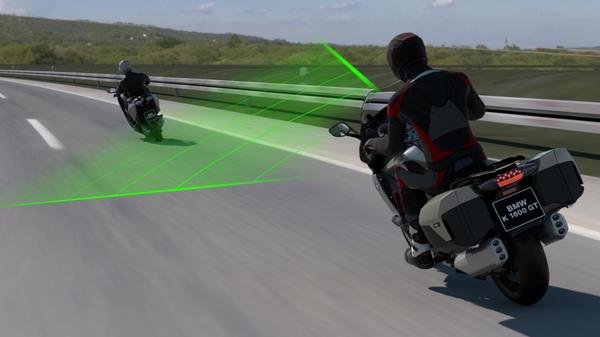
Active safety
The apparent dangers of life on two wheels can seem hard to reconcile, especially as cars get safer and safer. When you’re on top of the machine rather than in it there seems only so much you can do, but a two-way conversation with passenger car colleagues is helping BMW make biking safer.
For instance, research indicates one of the most common crashes is when a right-turning car cuts across an oncoming rider. Which has helped inform the development of more sophisticated automatic emergency braking systems now rolling out across the BMW passenger car range, these now able to slam the anchors on if a driver tries to pull across the path of an oncoming bike. With every generation the technology gets better as well, the operating range and speed sensitivity of the latest versions far exceeding that required by NCAP safety standards. On the Motorrad side there is an acceptance that technologies introduced on cars – ABS, traction control and the rest – often take years to filter through to two-wheelers. But with engineers working on both BMW has the in-house expertise to put a bike-friendly twist on automated assistance features like autonomous braking and distance sensing cruise control drivers have taken for granted for years. Obviously, you can’t have a bike slamming on the brakes on its own as a car might. But by tweaking the same sensors and algorithms BMW is building on its active cruise control to integrate non-invasive warnings to the rider. That can come through alerts on the instrument cluster to subtle pulses through the brakes, though the onus will always remain on the rider’s judgement on whether braking to a halt or an avoidance manoeuvre is the best course of action.
For instance, research indicates one of the most common crashes is when a right-turning car cuts across an oncoming rider. Which has helped inform the development of more sophisticated automatic emergency braking systems now rolling out across the BMW passenger car range, these now able to slam the anchors on if a driver tries to pull across the path of an oncoming bike. With every generation the technology gets better as well, the operating range and speed sensitivity of the latest versions far exceeding that required by NCAP safety standards. On the Motorrad side there is an acceptance that technologies introduced on cars – ABS, traction control and the rest – often take years to filter through to two-wheelers. But with engineers working on both BMW has the in-house expertise to put a bike-friendly twist on automated assistance features like autonomous braking and distance sensing cruise control drivers have taken for granted for years. Obviously, you can’t have a bike slamming on the brakes on its own as a car might. But by tweaking the same sensors and algorithms BMW is building on its active cruise control to integrate non-invasive warnings to the rider. That can come through alerts on the instrument cluster to subtle pulses through the brakes, though the onus will always remain on the rider’s judgement on whether braking to a halt or an avoidance manoeuvre is the best course of action.
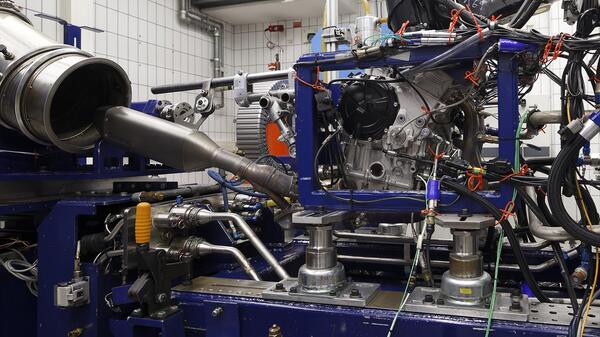
E-fuels
BMW is fully committed to phasing out internal combustion engines in its cars and going electric through increasingly effective hybrid technology. And, at least for the urban and commuter markets, electric scooters like the funky CE 04 prove ditching combustion engines hasn’t blunted Motorrad’s instinct for building cool-looking products, either.
BMW execs are treading carefully, but the divergence between those using electric bikes for mobility and combustion ones for leisure is something it needs to plan for. Especially given the longer working life your average bike has, and the fact the GSs and rest it sells now will likely still be in circulation 20 years down the line and beyond when cars are meant to have ditched fossil fuels entirely. Where does that leave combustion-engined bikers in a zero emissions world? Cue a visit to the engine test bench, where engineers are busy experimenting with ‘e-fuels’ in an attempt to future proof combustion engines. Porsche is doing similar with an eye to protecting the legacy of its combustion-engined cars, and investing heavily in renewably powered facilities capable of brewing what is, in effect, carbon neutral fuel. BMW is a little hazier on exactly where its e-fuels will come from, and whether it can achieve the same. But, safe to say, making sure we can ride combustion-engined bikes into the future is all part of the plan.
BMW execs are treading carefully, but the divergence between those using electric bikes for mobility and combustion ones for leisure is something it needs to plan for. Especially given the longer working life your average bike has, and the fact the GSs and rest it sells now will likely still be in circulation 20 years down the line and beyond when cars are meant to have ditched fossil fuels entirely. Where does that leave combustion-engined bikers in a zero emissions world? Cue a visit to the engine test bench, where engineers are busy experimenting with ‘e-fuels’ in an attempt to future proof combustion engines. Porsche is doing similar with an eye to protecting the legacy of its combustion-engined cars, and investing heavily in renewably powered facilities capable of brewing what is, in effect, carbon neutral fuel. BMW is a little hazier on exactly where its e-fuels will come from, and whether it can achieve the same. But, safe to say, making sure we can ride combustion-engined bikes into the future is all part of the plan.
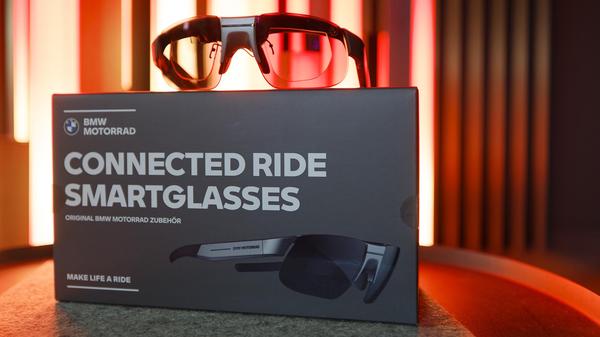
Wearable tech
While drivers of BMW passenger cars enjoy widescreen infotainment, head-up displays and all the support they need at their fingertips bikers have a slightly different interaction with connected devices. But the digital divide is shrinking, and we were shown a couple of products with that in mind.
With its configurable LED lighting and interactive features like dialling up a route home from a press of a button on the sleeve, BMW’s ‘connected jacket’ is an interesting spin on wearable tech. Though given its lowly protection rating and price it’s probably more for well-heeled urban commuters than serious riders, and possibly a bit of a gimmick. Perhaps more interesting for those who like to tour or expedition, BMW’s new ConnectedRide Smartglasses project navigation, speed and other information directly into your eyeline, much like a car’s head-up display. Co-developed with an Israeli tech firm called Everysight, BMW has added its app-powered functionality taking speed and other information directly from the bike. The 80s sports glasses style – and home market price of 699 Euros – may limit the appeal to all but the real technophiles. But it’s an interesting step into the augmented reality world for bikers.
With its configurable LED lighting and interactive features like dialling up a route home from a press of a button on the sleeve, BMW’s ‘connected jacket’ is an interesting spin on wearable tech. Though given its lowly protection rating and price it’s probably more for well-heeled urban commuters than serious riders, and possibly a bit of a gimmick. Perhaps more interesting for those who like to tour or expedition, BMW’s new ConnectedRide Smartglasses project navigation, speed and other information directly into your eyeline, much like a car’s head-up display. Co-developed with an Israeli tech firm called Everysight, BMW has added its app-powered functionality taking speed and other information directly from the bike. The 80s sports glasses style – and home market price of 699 Euros – may limit the appeal to all but the real technophiles. But it’s an interesting step into the augmented reality world for bikers.
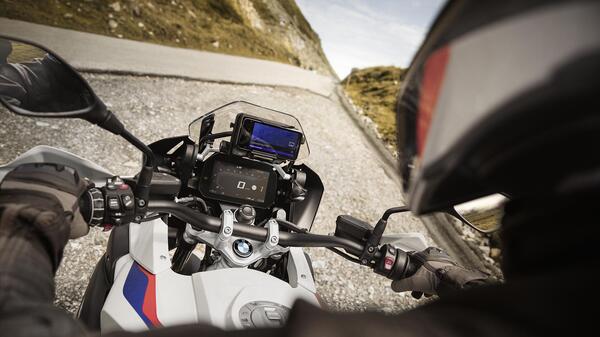
Next-gen chassis technology
We were also shown around BMW Motorrad’s suspension testing department, where all manner of clever stuff happens with shocks, forks and the systems controlling them. Active suspension is yet another technology transfer from passenger cars, with some of the engineers literally bringing the hardware and knowledge with them from BMW’s car side.
In the 20 years or so it’s been used on BMW’s bikes the active suspension technology has got more advanced, adapted car hardware now replaced by motorcycle specific components and calibrations. By making suspension adjustment a push-button job BMW has introduced riders to the idea of different set-ups for comfort or more performance-oriented handling, but the ambition has always been the ability to change spring rate and ride height in one go, the practical application of this meaning big adventure bikes that were once too tall for smaller riders can now automatically lower before feet need to touch the ground, all without compromising handling at higher speeds. We’ll leave you to make an informed guess about which new BMW may be bringing the technology to market but we get the feeling you won’t be waiting too long…
In the 20 years or so it’s been used on BMW’s bikes the active suspension technology has got more advanced, adapted car hardware now replaced by motorcycle specific components and calibrations. By making suspension adjustment a push-button job BMW has introduced riders to the idea of different set-ups for comfort or more performance-oriented handling, but the ambition has always been the ability to change spring rate and ride height in one go, the practical application of this meaning big adventure bikes that were once too tall for smaller riders can now automatically lower before feet need to touch the ground, all without compromising handling at higher speeds. We’ll leave you to make an informed guess about which new BMW may be bringing the technology to market but we get the feeling you won’t be waiting too long…